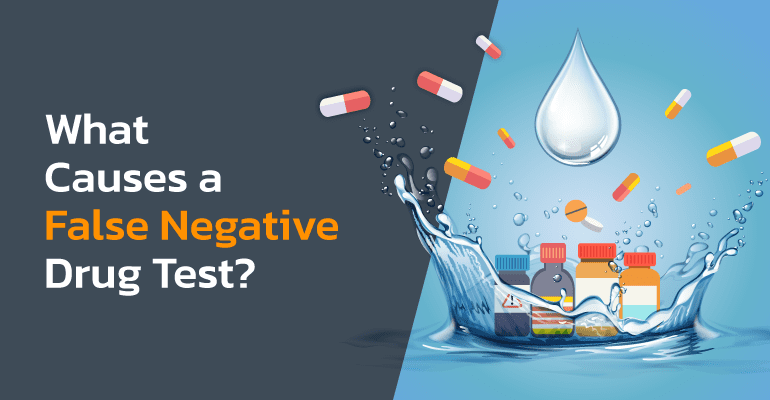A false negative drug test poses a serious problem in workplace testing and safety compliance. It happens when the test fails to detect a substance that is actually present in the sample. This can have dangerous consequences, especially in work environments where employee safety and regulatory adherence are critical. False negatives not only compromise the integrity of drug testing programs but also introduce legal and safety risks that could be avoided with more accurate results. Understanding what causes false negatives is vital for employers, safety managers, and workers.
At WorkforceQA, we are committed to providing comprehensive, reliable drug testing solutions that help employers maintain a safe and compliant workforce. With our expertise, we help organizations navigate the complexities of drug testing, ensuring accuracy and compliance at every step.
Understanding False Negative Drug Tests
A false-negative drug test occurs when the drug or its metabolites are present in the sample, but the test fails to detect them. This can occur for several reasons, and while the sample may be clean according to the test, it doesn’t truly reflect the presence of the substance.
In safety-sensitive industries, such as transportation, aviation, construction, and healthcare, the consequences of false negatives can be severe. Imagine an impaired driver getting behind the wheel or an operator under the influence of drugs while handling heavy machinery. In these environments, ensuring accuracy in drug testing is crucial to employee safety and legal compliance.
5 Key Factors That Cause False Negative Drug Tests
Several factors can lead to false negatives in drug testing, making it essential to employ specimen validity testing processes and safeguards to identify the causes of these inaccuracies. From issues related to the sample itself to limitations in the testing methods, false negatives can stem from a variety of sources.
1. Dilution or Adulteration of the Sample
Excessive Fluid Intake
One of the most common reasons for a false negative result is sample dilution. When an individual consumes excessive amounts of water or other fluids, it can dilute the urine to the point where the concentration of drug metabolites is too low to be detected. This is particularly relevant in workplace drug testing, where individuals may attempt to “flush” out drugs by drinking large quantities of liquids.
Adulterants
Adulterants are chemicals or substances that are added to the sample in an attempt to tamper with the results. Common adulterants include household chemicals such as bleach and oxidizing agents, as well as other substances designed to interfere with the test’s ability to detect drugs.
2. Low Drug Concentration in the Sample
Below the Cutoff Level
Each drug test has a cutoff level that determines whether the test result will be positive or negative. If the concentration of the drug in the sample falls below this threshold, even if the drug is present, the result will be reported as negative.
Time Since Last Use
The time between drug use and testing can also play a critical role in whether drugs are detected. If too much time has passed, the concentration of the drug or its metabolites may drop below the detection threshold, resulting in a false negative.
3. Specificity and Sensitivity of the Test
Not all drug tests are the same. Some tests have a higher specificity and sensitivity for detecting certain substances than others. For example, some tests might miss specific benzodiazepines or opioids because they are not sensitive enough.
Metabolism Differences
Personal factors, such as metabolism, age, gender, and overall health, can influence the body’s ability to process drugs. People with faster metabolisms may clear drugs from their system more quickly, resulting in lower concentrations in the sample that might fall below the detection threshold.
4. Testing Errors and Procedural Issues
Improper Sample Collection or Handling
Contamination, mishandling, or improper storage of a sample can lead to inaccuracies and contribute to false negatives. For example, if the sample is not collected in a clean container or stored at the proper temperature, the test results may not accurately reflect the presence of drugs.
Laboratory Errors
Although rare, laboratory errors can also lead to false negatives. These may include issues such as incorrect sample processing, improper reagent use, or inadequate calibration of equipment.
5. Other Contributing Factors
Medications and Health Conditions
Certain medications, such as those prescribed for chronic illnesses, may interfere with drug testing by masking or altering the way drugs are metabolized. For instance, medications like diuretics can dilute urine, while kidney conditions may impact how the body processes substances.
Synthetic Drugs
Standard drug tests are often not designed to detect synthetic drugs, such as synthetic opioids (e.g., fentanyl). These substances are not usually included in the basic 5-panel drug test used for workplace testing, leading to false negative results for those drugs.
Detecting Attempts to Cause False Negatives
By partnering with trusted employee screening providers like WorkforceQA, employers can ensure that drug tests are legitimate and that employees are held accountable for their actions. These steps, such as specimen validity testing, also protect organizations from the legal and safety consequences that may arise if false negatives are left undetected.
Visual Inspection Methods
Trained professionals typically conduct visual inspections of the urine sample to detect signs of tampering. This includes looking for changes in color or consistency, which could indicate adulteration. For instance, a urine sample that is unusually clear or has an unnatural color may suggest dilution or tampering.
Temperature Checks
Temperature is another important indicator of sample validity. Urine samples should be within a specific temperature range (90°F to 100°F) to ensure that the sample has not been substituted or tampered with.
Specimen Validity Testing
Adulteration Detection Kits
There are specialized tests available that can detect common adulterants in urine samples, such as bleach and vinegar, as well as other chemicals that individuals may use to attempt to interfere with the test. These tests help ensure the sample is legitimate and have become essential tools in detecting false negatives.
Specific Gravity Testing
Specific gravity testing is used to determine whether a sample has been diluted excessively. If the specific gravity of the sample is too low, it suggests that the individual may have consumed excessive fluids to reduce the concentration of drugs.
How WorkforceQA Prevents False Negative Results
Preventing false negatives is essential to maintaining the accuracy, reliability, and integrity of any drug testing program. WorkforceQA (WFQA) upholds the highest standards in specimen collection, laboratory analysis, and result verification. With nationwide clinics, on-site testing, and partnerships with SAMHSA/DHHS-certified laboratories, WFQA ensures every test meets strict regulatory and scientific standards.
1. Expert Sample Collection and Secure Chain of Custody
Accurate results begin with expert collection and rigorous chain-of-custody management. WFQA ensures that every specimen is handled by certified professionals and tracked through every stage of the testing process.
- Certified collectors perform each collection following federally recognized procedures, minimizing handling errors and ensuring compliance.
- Strict chain-of-custody documentation prevents tampering, mislabeling, or mix-ups at any point.
- Proper storage and temperature-controlled transport maintain specimen integrity from the collection site to the laboratory.
- Flexible testing options—including on-site, mobile, and clinic-based services—deliver both accuracy and convenience.
2. Sensitive, Specific, and Scientifically Verified Testing Methods
False negatives can occur when testing methods fail to detect low concentrations or certain drug metabolites. WFQA minimizes this risk by implementing multi-tiered testing protocols and industry-leading technology.
- All specimens are analyzed in SAMHSA/DHHS-certified laboratories, ensuring compliance with federal testing standards.
- Initial immunoassay screenings are followed by confirmatory testing using advanced techniques such as Gas Chromatography–Mass Spectrometry (GC-MS) and High-Performance Liquid Chromatography (HPLC).
- Testing protocols and instrumentation are regularly updated to align with current Department of Health and Human Services (DHHS) and industry best practices.
- Every result undergoes review by certified laboratory scientists and Medical Review Officers (MROs) to verify accuracy and ensure compliance.
3. Continuous Quality Control and Process Improvement
Maintaining accuracy requires consistent oversight, performance monitoring, and continuous improvement.
- Routine quality audits evaluate every phase of the collection, testing, and reporting process.
- Performance monitoring detects and corrects potential issues before they impact results.
- Ongoing staff training ensures collectors, technicians, and reviewers stay current on evolving standards, regulations, and technology.
- Continuous improvement initiatives ensure WFQA’s testing protocols reflect the latest scientific advancements and compliance requirements.
Trusted Accuracy. Proven Compliance.
By partnering with WorkforceQA, employers can trust that every test is collected, processed, and analyzed with precision. From certified collectors to SAMHSA/DHHS-certified laboratories, WFQA delivers consistent, defensible, and compliant results—helping organizations maintain safe, drug-free workplaces with total confidence.
When to Consider Retesting
In some cases, a false negative may require further investigation to ensure the accuracy and reliability of the drug test results. While a single test result may not always be definitive, certain situations or red flags can indicate the need for retesting. False negatives can occur for various reasons; therefore, it’s essential to remain vigilant and consider retesting when necessary.
Suspicious Circumstances
If test results are inconsistent—such as an employee with a known history of drug use who suddenly tests negative, it may be time to retest.
Follow-up Testing Protocols
Employers should have follow-up testing protocols in place if there is suspicion that a false negative occurred. This may include:
- Random Testing: A random drug testing program helps keep employees accountable and deters attempts to circumvent drug tests.
- Scheduled Follow-ups: Follow-up tests at regular intervals after the initial screening can help identify ongoing drug use or additional attempts to tamper with the results.
Legal and Workplace Considerations
While maintaining the integrity and accuracy of your drug testing program, it’s also important to consider the legal and regulatory framework that governs testing practices. Complying with industry standards and government regulations not only helps avoid legal issues but also ensures your testing protocols are strong and aligned with best practices.
Regulatory Standards for Drug Testing
Workplace drug testing is governed by various regulations, such as DOT pre-employment drug tests for transportation industries and DHHS guidelines for safety-sensitive sectors. Ensuring compliance with these rules is crucial to avoid legal issues and maintain a safe workplace.
Workplace Testing Policies
A clear and comprehensive drug testing policy is essential for maintaining workplace safety and ensuring compliance. Employers should:
- Define procedures for testing, reporting, and addressing false negatives.
- Establish protocols for random and scheduled testing to prevent missed drug use.
Legal Implications of False Negatives
False negatives can lead to serious legal consequences. Employers may face lawsuits if an employee who tests negative is involved in an incident while under the influence of drugs. Proactive drug testing practices are crucial in reducing this risk and protecting your organization.
Effective Drug Testing with WorkforceQA
Understanding the causes of false negative drug tests is crucial for both employers and employees to maintain safety and ensure compliance in the workplace. By identifying the factors that lead to false negatives and applying best practices for testing and sample collection, organizations can minimize the risk of inaccurate results and improve workplace safety.
Learn more about WorkforceQA’s Drug and Alcohol Testing Services to help ensure your organization’s drug testing program is thorough, compliant, and effective at preventing false negative results.





